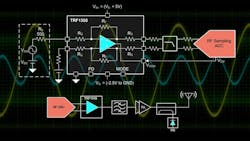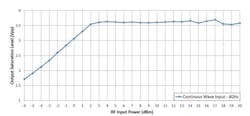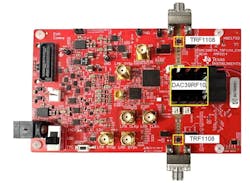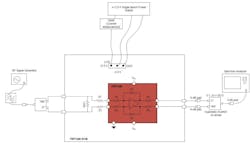Members can download this article in PDF format.
Test and measurement instruments and systems can get a performance boost when they incorporate advanced radio-frequency (RF) devices. These include RF fully differential amplifiers (FDAs), RF differential to single-ended amplifiers, RF sampling analog-to-digital converters (ADCs), and RF digital-to-analog converters (DACs).
These devices can help high-bandwidth oscilloscopes, RF digitizers, and RF arbitrary waveform generators effectively deal with factors such as higher data rates in wireless transceivers and narrower pulses in radar systems.
RF FDAs for Oscilloscopes and Digitizers
Traditionally, designers have employed analog mixers followed by narrowband ADCs to digitize high-frequency signals. This approach leads to high levels of circuit complexity, though, as well as performance limitations. Consequently, designers have replaced the mixers and narrow-bandwidth ADCs with RF sampling ADCs, which directly accept differential inputs, thereby inherently rejecting common-mode noise.
But since designers were continuing to employ single-ended gain blocks, they needed to add transformer-based passive baluns to develop the differential input signals required by the ADCs. The baluns impose their own drawbacks: They’re bulky and expensive, and they can place a lower limit of hundreds of kilohertz or even tens of megahertz on the frequencies that such a circuit can digitize, whereas test and measurement instruments would ideally digitize signals down to DC. In addition, baluns may exhibit second-order nonlinearities because of gain and phase imbalance.
These second-order effects aren’t particularly detrimental to narrowband systems, because the nonlinearities manifest themselves outside the frequency range of interest. However, for RF instruments such as oscilloscopes, every frequency within the instruments’ specified range is potentially a frequency of interest, and high levels of second-order nonlinearities can’t be tolerated.
To overcome these drawbacks, you can use a DC-coupled RF FDA such as the Texas Instruments TRF1305, a closed-loop dual-channel RF amplifier that offers a 3-dB bandwidth of DC to more than 6.5 GHz and a typical gain of 10 dB. The device makes it possible to set different input and output common-mode voltages for applications involving level shifting.
The TRF1305 can perform single-ended to differential conversion (Fig. 1), which could be part of a receiver signal chain or an oscilloscope or digitizer input, for example. Here, the device accepts a single-ended AC plus DC input and drives a differential RF sampling ADC.
In addition to delivering a balanced differential output to drive the RF sampling ADC, the RF FDA can protect your RF sampling ADC from damage—an important consideration because the ADC is often the most expensive component in your signal chain.
For instance, Figure 2 shows the output power of a TI TRF1208—a single-ended to differential amplifier with a 3-dB bandwidth of 10 MHz to 11 GHz and a gain of 16 dB—when overdriven by a 4-GHz continuous-wave input. The TRF1208’s output saturates at a 3.6-V (peak-to-peak) level when its input reaches 2 dBm, inherently protecting the ADC and other downstream components.
Amplifiers for Arbitrary Waveform Generators
In addition to working with an ADC to digitize an analog signal, a differential amplifier can also work with a DAC in a transmit-signal-chain or arbitrary-waveform-generator design. As was the case for the receiver signal chain in Figure 1, advanced data converters can replace a mixer, which traditionally provided frequency upconversion in a transmitter.
Figure 3 shows an RF DAC delivering a differential signal to a TI TRF1108 differential to single-ended RF amplifier, which offers a 3-dB bandwidth of 10 MHz to 12 GHz and a gain of 15.5 dB. In a reverse of the receiver signal-chain approach, the TRF1108 converts the differential signal to a single-ended signal, which it provides to a filter bank, power amplifier (PA), and antenna.
The Figure 3 approach eliminates the need for passive baluns to convert the DAC differential output to a single-ended signal, thereby saving printed-circuit-board (PCB) real estate and eliminating the insertion loss that a balun would add to the circuit.
Evaluation Modules
The compactness of the TRF1108 is evidenced with the TRF1108-DAC39RFEVM evaluation module (EVM) (Fig. 4), which can help get you started on designs based on the TRF1108, plus the DAC39RF10 RF DAC. The latter is a 16-bit two-channel device that operates at input sample rates to 20.48 GS/s and delivers an RF output up to 12 GHz.
With a 2- × 2-mm footprint, the two TRF1108 devices on the EVM take up minimal PCB space. The complete EVM allows you to experiment with applying the DAC and amplifier to applications ranging from phased-array antenna systems to wireless communications testers.
TI offers a variety of EVMs in addition to the one shown in Figure 4. For example, the TRF1305B2-D2D-EVM helps you evaluate the TRF1305 RF FDA and learn how to apply its 10-dB gain, high linearity, and wide bandwidth to your application. It comes configured for split power-supply operation, but you can modify it to operate from a single 5-V supply.
The EVM accepts both single-ended and differential input signals, and it easily connects to test equipment having standard 50-W inputs and outputs. Figure 5 shows a single-tone instrument setup for measuring parameters such as the TRF1305’s gain and 1-dB compression point (P1dB).
Conclusion
RF sampling ADCs excel at digitizing high-frequency signals, while RF DACs bring comparable benefits to the conversion of high-speed digital bitstreams to RF signals. But both the ADCs and DACs need an assist from differential amplifiers. TI offers a full line of RF FDAs that can work in concert with RF sampling ADCs in the input channels of instruments such as oscilloscopes to digitize RF signals of interest.
Similarly, the company offers differential to single-ended amplifiers that can work with RF DACs in instruments such as arbitrary waveform generators. In addition, the company offers EVMs that help get you started on designs using differential signals.





